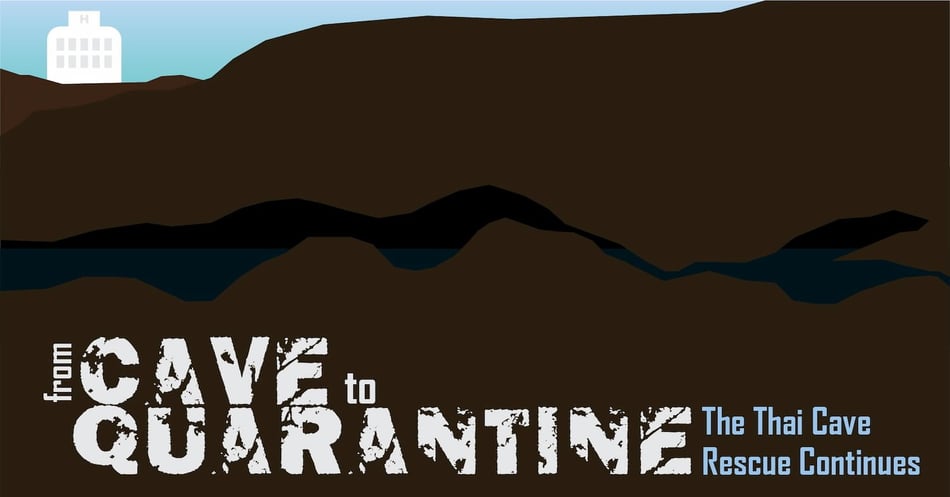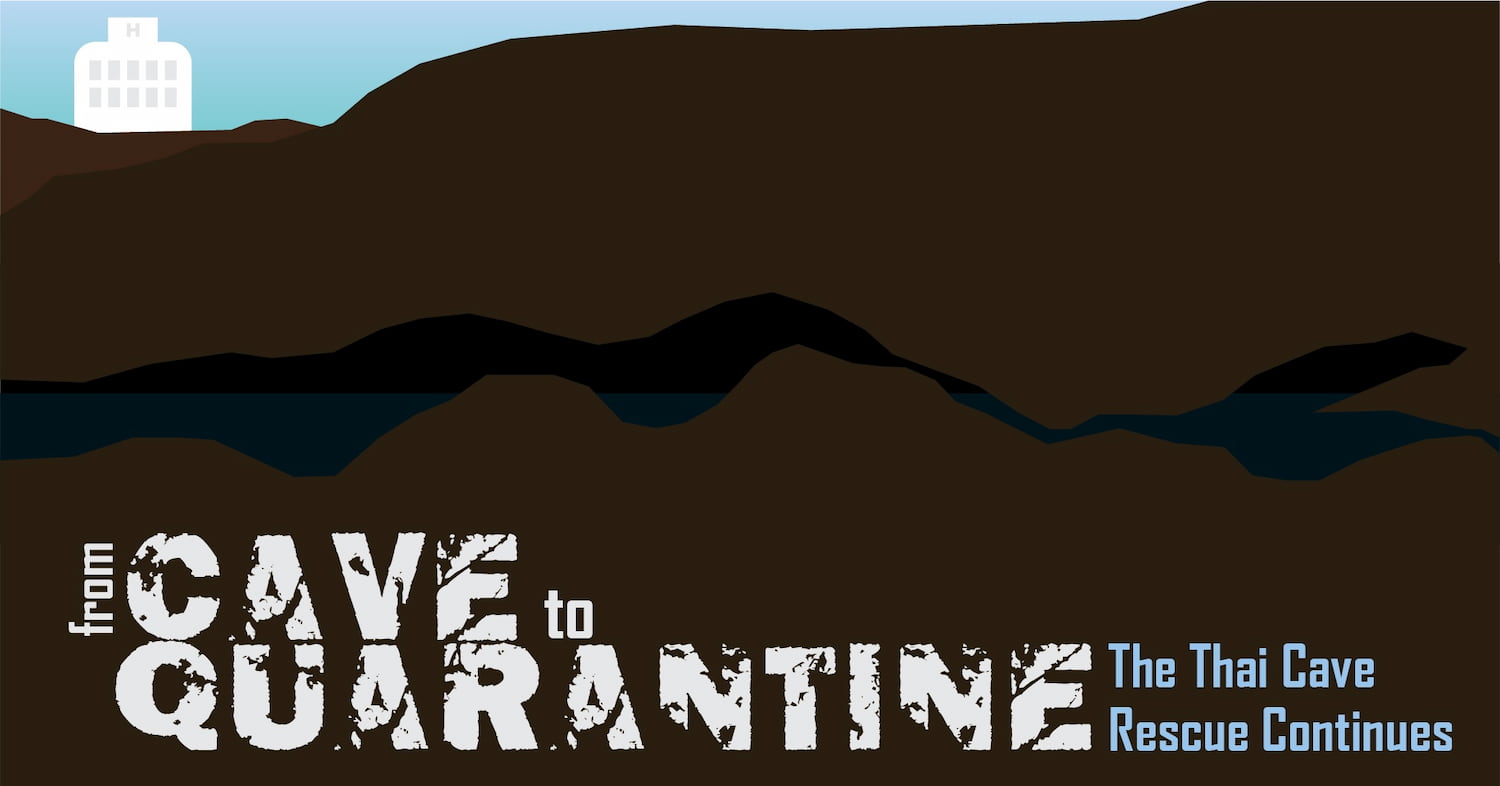From Cave to Quarantine: The Thai Rescue Continues

 The world shared a collective sigh of relief as word spread that the last of the trapped Thai soccer team was rescued from their 17-day underground ordeal. After international efforts to find the lost team, the immediate tasks centered on providing the malnourished and weak group with immediate medical care. While plans for their extraction were going full-force, the twelve boys and their coach received food, clean water, and most importantly, oxygen to the tiny rock shelf that had provided shelter as monsoon flood waters rose around them. With the entire group now safely above-ground, it appears the worst of the ordeal is behind them. As the boys recover under quarantine, medical specialists now have the task of determining what, if any, pathogens followed them out of this nightmare. Today’s post will explore some of the infection risks faced by this group as the rescue efforts continue at the patient bedside.
The world shared a collective sigh of relief as word spread that the last of the trapped Thai soccer team was rescued from their 17-day underground ordeal. After international efforts to find the lost team, the immediate tasks centered on providing the malnourished and weak group with immediate medical care. While plans for their extraction were going full-force, the twelve boys and their coach received food, clean water, and most importantly, oxygen to the tiny rock shelf that had provided shelter as monsoon flood waters rose around them. With the entire group now safely above-ground, it appears the worst of the ordeal is behind them. As the boys recover under quarantine, medical specialists now have the task of determining what, if any, pathogens followed them out of this nightmare. Today’s post will explore some of the infection risks faced by this group as the rescue efforts continue at the patient bedside.
Quarantine - a term derived from the 40-day waiting period for ships from plague-ridden countries at 1660s Venice ports - protects both the patient and those around him. The rescued group is currently being treated in quarantine to protect them, with their weakened immune system, from contracting any infection from a visitor. (They are not thought to carry an infectious disease.) Even mild infections could become life-threatening to a person with a weak immune system, as we all know from our familiarity with contact precautions in healthcare facilities. These boys, who survived under extremely difficult conditions for two weeks, not only are weak and malnourished, they may also be facing infections they contracted while in the cave.
Tropical caves - damp, dark, and full of wildlife - are notoriously full of potentially dangerous pathogens. Under constant saturation with water from above and below-ground, tropical cave systems can have 100% humidity throughout their tunnels. This degree of humidity means the air is full of water droplets, the perfect vehicle for fungi. Water also drips down the walls to collect on the floor, mixing with mud and animal droppings to create a perfect environment for bacteria to flourish. The wildlife also presents a danger: Bites or scratches from bats, birds, or rats can transmit various viruses, while a dangerous bacterial infection can be transmitted by tick bites.
Here are the most threatening pathogens the team may have encountered:
Histoplasa capsulatum | Histoplasmosis | fungus
Histoplasmosis is so strongly associated with caves that it is also knows as “cave disease.” Fungal spores live in soil and propagate quickly when nourished by nitrate-laden bat droppings. Aerisolization occurs when the mud and guano mix is disturbed. The more spores inhaled, the more severe the infection. Mild cases resolve on their own, while severe cases require intense medical intervention.
Leptospira spp. | Leptospirosis | bacteria
Bats and rats, especially those that inhabit caves, often carry this corkscrew-shaped bacteria. The bodily fluids of these animals contaminate cave water sources, where it can enter our bodies via cuts, mucous membranes, or by being inhaled. Treatable with antibiotics, this illness, also called “Weil’s disease,” is not usually life-threatening.
Burkholderia pseudomallei | Melioidosis | bacteria
A sneaky bacteria that can lay dormant for decades, this bacterial infection earned the name “Vietnam Time Bomb” from the number of US soldiers who became symptomatic years or decades after returning home. Milder infections can affect the skin or lungs, with more severe infections reaching the bloodstream and the entire body. Treatable with prompt IV antibiotics and maintenance antibiotics over several months, melioidosis becomes a greater threat when not diagnosed soon enough.
Less likely are a variety of viruses transmitted through bat or rodent bites, including Nipah virus, Marburg Hemmorhagic Fever, and rabies. However, there is a slim chance that the boys encountered wildlife in the caves. They did not report seeing any, and animals are known to avoid cave systems during times of flooding.
In addition to the exotic pathogens they may have encountered in the caves, the boys also had to live with more common bacteria found in and on their own bodies. Due to poor sanitation, the boys may have been exposed to waste carrying E. coli and other bacteria responsible for GI issues. Any skin abrasions might also be infected from normal skin flora, including S. aureus. Thankfully, the antibiotics provided upon discovery will most likely control these infections quickly, and as they get stronger, their own immune systems will kick in and help return the boys to the soccer field.
We at EOS Surfaces join the world in celebrating the rescue of the team and their coach, and the efforts by all those involved in that rescue. We particularly want to take a moment to honor Thai Navy SEAL Salam Gunan, who gave his life while trying to deliver oxygen to the trapped boys. Rest In Peace.
![EOScu Logo - Dark - Outlined [07182023]-01](https://blog.eoscu.com/hubfs/Eoscu_June2024/Images/EOScu%20Logo%20-%20Dark%20-%20Outlined%20%5B07182023%5D-01.svg)




